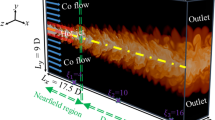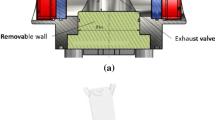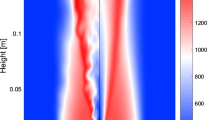Abstract
Direct numerical simulations (DNS) of a hot combustion product jet interacting with a lean premixed hydrogen-air coflow are conducted to fundamentally investigate turbulent jet ignition (TJI) in a three-dimensional configuration. TJI is an efficient method for initiating and controlling combustion in ultra-lean combustion systems. Fully compressible gas dynamics and species equations are solved with high order finite difference methods. The hydrogen-air reaction is simulated with a reliable detailed chemical kinetics mechanism. The physical processes involved in the TJI-assisted combustion are investigated by considering the flame heat release, temperature, species concentrations, vorticity, and Baroclinc torque. The complex turbulent flame and flow structures are delineated in three main: i) hot product jet, ii) burned-mixed, and iii) flame zones. In the TJI-assisted combustion, the flow structures and the flame features such as flame speed, temperature, and species distribution are found to be quite different than those in “standard” turbulent premixed combustion due to the existence of a high energy turbulent hot product jet. The flow structures and statistics are also found to be different than those normally seen in non-isothermal non-reacting jets.





















Similar content being viewed by others
References
Lodier, G., Merlin, C., Domingo, P., Vervisch, L., Ravet, F.: Self-ignition scenarios after rapid compression of a turbulent mixture weakly-stratified in temperature. J. Combust. Flame 159(11), 3358–3371 (2012)
Jin, T., Luo, K., Lu, S., Fan, J.: DNS, investigation on flame structure and scalar dissipation of a supersonic lifted hydrogen jet flame in heated coflow. Int. J. Hydro. Energy 38(23), 9886–9896 (2013)
Mittal, G., Raju, M., Sung, C.: CFD, modeling of two-stage ignition in a rapid compression machine: Assessment of zero-dimensional approach. J. Combust. Flame 157(7), 1316–1324 (2010)
Carpio, J., Iglesias, I., Vera, M., Sánchez, A., Liñán, A.: Critical radius for hot-jet ignition of hydrogen–air mixtures. Int. J. Hydro. Energy 38(7), 3105–3109 (2013)
Dorofeev, S., Bezmelnitsin, A., Sidorov, V., Yankin, J., Matsukov, I.: Turbulent jet initiation of detonation in hydrogen-air mixtures. Shock Waves 6(2), 73–78 (1996)
Ghorbani, A., Steinhilber, G., Markus, D., Maas, U.: Ignition by transient hot turbulent jets: An investigation of ignition mechanisms by means of a pdf/redim method. Proc. Combust. Inst. 35(2), 2191–2198 (2015)
Boivin, P., Dauptain, A., Jiménez, C., Cuenot, B.: Simulation of a supersonic hydrogen–air autoignition-stabilized flame using reduced chemistry. J. Combust. Flame 159(4), 1779–1790 (2012)
Djebaili, N., Lisbet, R., Dupre, G., Patillard, C.: Ignition of a combustible mixture by a hot unsteady gas jet. Combust. Sci. Technol. 104, 273–285 (1995)
Iglesias, I., Vera, M., Sanchez, A.L., Linan, A.: Numerical analyses of deflagration initiation by a hot jet. Combust. Theory Modell. 16(6), 994–1010 (2012)
Phillips, H.: Ignition in a transient turbulent jet of hot inert gas. J. Combust. Flame 19(2), 187–195 (1972)
Sadanandan, R., Markus, D., Schießl, R., Maas, U., Olofsson, J., Seyfried, H., Richter, M., AldénAldén, M.: Detailed investigation of ignition by hot gas jets. Proc. Combust. Inst. 31(1), 719–726 (2007)
Pope, S.: Turbulent Flows. Cambridge University Press, New York (2000)
James, S., Jaberi, F.A.: Large scale simulations of two-dimensional nonpremixed methane jet flames. J. Combust. Flame 123(4), 465–487 (2000)
Gordeyev, S., Thomas, F.: Coherent structure in the turbulent planar jet. Part 1. Extraction of proper orthogonal decomposition eigenmodes and their self-similarity. J. Fluid Mech. 414, 145–194 (2000)
Gunnar, H.: Hot-wire measurements in a plane turbulent jet. J. Appl. Mech. 32 (4), 721–734 (1965)
Hinze, J.: Turbulence. McGraw-Hill, New York (1975)
Pope, S.: Calculations of a plane turbulent jet. AIAA J. 22(7), 896–904 (1983)
Heskestad, G.: Hot-wire measurements in a plane turbulent jet1. J. Appl. Mech. 32, 721–734 (1965)
Kee, R., Rupley, F., Miller, J.: Chemkin-II: A Fortran chemical kinetics package for the analysis of gas-phase chemical kinetics (1989)
Jaberi, F., Miller, R., Mashayek, F., Givi, P.: Differential diffusion in binary scalar mixing and reaction. J. Combust. Flame 109(4), 561–577 (1997)
Stahl, G., Warnatz, J.: Numerical investigation of time-dependent properties and extinction of strained methane and propane-air flamelets. J. Combust. Flame 06, 285–299 (1991)
Arndt, C., Schiel, R., Gounder, J., Meier, W., Aigner, M.: Flame stabilization and auto-ignition of pulsed methane jets in a hot coflow: Influence of temperature. Proc. Combust. Inst. 34(1), 1483–1490 (2013)
Bezgin, L., Kopchenov, V., Sharipov, A., Titova, N., Starik, A.: Evaluation of prediction ability of detailed reaction mechanisms in the combustion performance in hydrogen/air supersonic flows. Combust. Sci. Technol. 185(1), 62–94 (2013)
Ju, Y., Niioka, T.: Reduced kinetic mechanism of ignition for nonpremixed hydrogen/air in a supersonic mixing layer. J. Combust. Flame 99, 240–246 (1994)
Vagelopoulos, C., Egolfopoulos, F., Law, C.: Further considerations on the determination of laminar flame speeds with the counterflow twin-flame technique. Symp.(Int.) Combust. 25(1), 1341–1347 (1994)
Lele, S.: Compact finite difference schemes with spectral-like resolution. J. Comput. Phys. 103(1), 16–42 (1992)
Poinsot, T., Lelef, S.: Boundary conditions for direct simulations of compressible viscous flows. J. Comput. Phys. 101(1), 104–129 (1992)
Kennedy, C., Carpenter, M., Lewis, R.: Low-storage, explicit runge–kutta schemes for the compressible navier–stokes equations. Appl. Numer. Math. 35(3), 177–219 (2000)
Afshari, A., Jaberi, F., Shih, T. P.: Large-eddy simulations of turbulent flows in an axisymmetric dump combustor. AIAA J. 46(7), 1576–1592 (2008)
Banaeizadeh, A., Afshari, A., Schock, H., Jaberi, F.: Large-eddy simulations of turbulent flows in internal combustion engines. Int. J Heat Mass Transfer 60, 781–796 (2013)
Banaeizadeh, A., Li, Z., Jaberi, F.: Compressible scalar filtered mass density function model for high-speed turbulent flows. AIAA J. 49(10), 2130–2143 (2011)
Li, Z., Banaeizadeh, A., Rezaeiravesh, S., Jaberi, F.: Advanced modeling of high speed turbulent reacting flows. In: 50th AIAA Aerospace Sciences Meeting (2012)
Steinberger, C., Vidoni, T., Givi, P.: The compositional structure and the effects of exothermicity in a nonpremixed planar jet flame. J. Combust. Flame 94(3), 217–232 (1993)
Rehm, J., Clemens, N.: The relationship between vorticity/strain and reaction zone structure in turbulent non-premixed jet flames. Symp. (Int.) Combust. 27(1), 1113–1120 (1998)
Yaldizli, M., Mehravaran, K., Mohammad, H., Jaberi, F.: The structure of partially premixed methane flames in high-intensity turbulent flows. J. Combust. Flame 154(4), 692–714 (2008)
Donovan, L., Todd, C.: Computer program for calculating isothermal turbulent jet mixing of two gases (1968)
Pathak, M., Dewan, A., Dass, A.: Computational prediction of a slightly heated turbulent rectangular jet discharged into a narrow channel crossflow using two different turbulence models. Int. J. Heat Mass Transfer 49(21–22), 3914–3928 (2006)
Pitts, W.: Importance of isothermal mixing processes to the understanding of lift-off and blowout of turbulent jet diffusion flames. J. Combust. Flame 76(2), 197–212 (1989)
Rowinski, D., Pope, S.: An investigation of mixing in a three-stream turbulent jet. Phys. Fluids 25(10), 105–140 (2013)
Rutland, C., Trouvé, A.: Direct simulations of premixed turbulent flames with nonunity lewis numbers. J. Combust. Flame 94(1–2), 41–57 (1993)
Nikolaou, Z., Swaminathan, N.: Heat release rate markers for premixed combustion. J.s Comb. Flame 161(12), 3073–3084 (2014)
Paul, P., Najm, H.: Planar laser-induced fluorescence imaging of flame heat release rate. Symp. (Int.) Combust. 27(1), 43–50 (1998)
Najm, H., Paul, P., Mueller, C., Wyckoff, P.: On the adequacy of certain experimental observables as measurements of flame burning rate. J. Combust. Flame 113(3), 312–332 (1998)
Clavin, P.: Dynamic behavior of premixed flame fronts in laminar and turbulent flows. Progress Energy Combust. Sci. 11(1), 1–59 (1985)
Pope, S.: Turbulent premixed flames. Ann. Rev.of Fluid Mech. 19, 237–270 (1987)
Boger, M., Veynante, D., Boughanem, H., Trouvé, A.: Direct numerical simulation analysis of flame surface density concept for large eddy simulation of turbulent premixed combustion. Symp. (Int.) Combust. 27(1), 917–925 (1998)
Driscoll, J.: Turbulent premixed combustion: Flamelet structure and its effect on turbulent burning velocities. Progress Energy Combust. Sci. 34(1), 91–134 (2008)
Gicquel, O., Darabiha, N., Thévenin, D.: Liminar premixed hydrogen/air counterflow flame simulations using flame prolongation of ildm with differential diffusion. Proc. Combust. Inst. 28(2), 1901–1908 (2000)
Griffiths, R., Chen, J., Kolla, H., Cant, R., Kollmann, W.: Three-dimensional topology of turbulent premixed flame interaction. Proc. Combust. Inst. 35(2), 1341–1348 (2015)
Lee, D, Huh, K.: DNS, analysis of propagation speed and conditional statistics of turbulent premixed flame in a planar impinging jet. Proc. Combust. Inst. 33(1), 1301–1307 (2011)
Lipatnikov, A., Chomiak, J.: Effects of premixed flames on turbulence and turbulent scalar transport. Progress Energy Combust. Sci 36(1), 1–102 (2010)
Lipatnikov, A., Chomiak, J., Sabelnikov, V., Nishiki, S., Hasegawa, T.: Unburned mixture fingers in premixed turbulent flames. Proc. Combust. Inst. 35(2), 1401–1408 (2015)
Lu, S., Fan, J., Luo, K.: High-fidelity resolution of the characteristic structures of a supersonic hydrogen jet flame with heated co-flow air. Int. J. Hydro. Energy 37 (4), 3528–3539 (2012)
Wang, H., Luo, K., Lu, S., Fan, J.: Direct numerical simulation and analysis of a hydrogen/air swirling premixed flame in a micro combustor. Int. J. Hydro. Energy 36(21), 13838–13849 (2011)
Kotsovinos, N.: A note on the spreading rate and virtual origin of a plane turbulent jet. J. Fluid Mech. 77, 305–311 (1976)
Beerer, D., McDonell, V., Therkelsen, P., Cheng, R.K.: Flashback and turbulent flame speed measurements in hydrogen/methane flames stabilized by a low-swirl injector at elevated pressures and temperature. J. Eng. Gas Turbi. Power 136, 20242–20254 (2014)
Lin, Y., Jansohn, P., Boulouchos, K.: Turbulent flame speed for hydrogen-rich fuel gases at gas turbine relevant conditions. Int. J. Hydro. Energy 39(35), 20242–20254 (2014)
Seitzman, J., Lieuwen, T.: Turbulent flame propagation characteristics of high hydrogen content fuels (2014)
Wang, J., Yu, S., Zhang, M., Jin, W., Huang, Z., Chen, S., Kobayashi, H: Burning velocity and statistical flame front structure of turbulent premixed flames at high pressure up to 1.0. Exper. Thermal Fluid Sci. 68, 196–204 (2015)
Kriaa, W., Abderrazak, K., Mhiri, H., Le Palec, G., Bournot, P.: A numerical study of non-isothermal turbulent coaxial jets. J. Heat Mass Transfer 44(9), 1051–1063 (2007)
Westerweel, J., Petracci, A., Delfos, R., Hunt, J.C.R.: Characteristics of the turbulent/non-turbulent interface of a non-isothermal jet. Philos. Trans. R Soc. London Math. Phys. Eng. Sci. 369(1937), 723–737 (2011)
Acknowledgements
This work was supported by the National Science Foundation under grant CBET-1258581. The authors would like to acknowledge the Institute for Cyber-Enabled Research at Michigan State University and the Texas Advanced Computing Center at the University of Texas at Austin for providing HPC resources.
Author information
Authors and Affiliations
Corresponding author
Rights and permissions
About this article
Cite this article
Validi, A., Jaberi, F. Numerical Study of Turbulent Jet Ignition in a Lean Premixed Configuration. Flow Turbulence Combust 100, 197–224 (2018). https://doi.org/10.1007/s10494-017-9837-7
Received:
Accepted:
Published:
Issue Date:
DOI: https://doi.org/10.1007/s10494-017-9837-7




